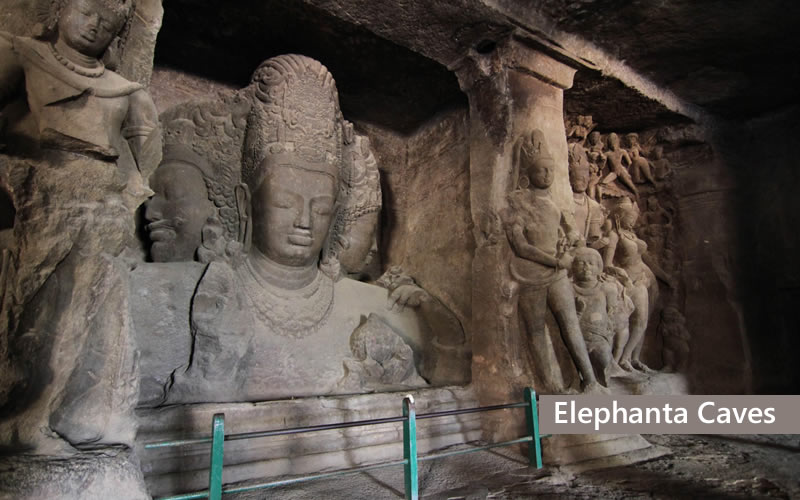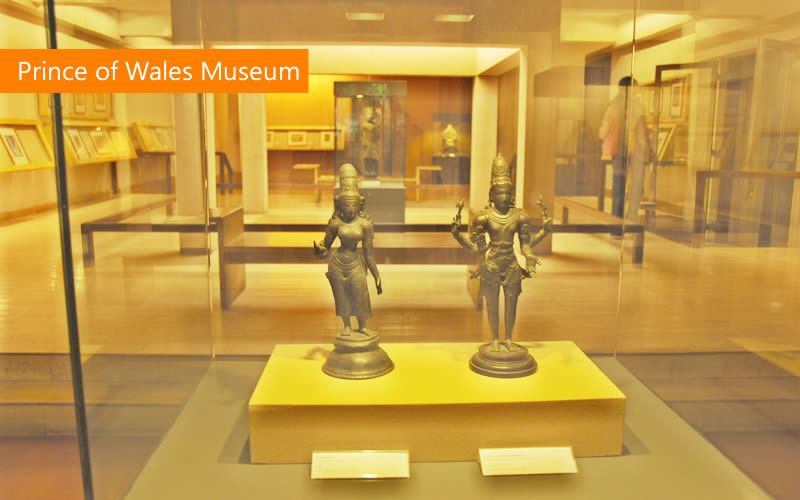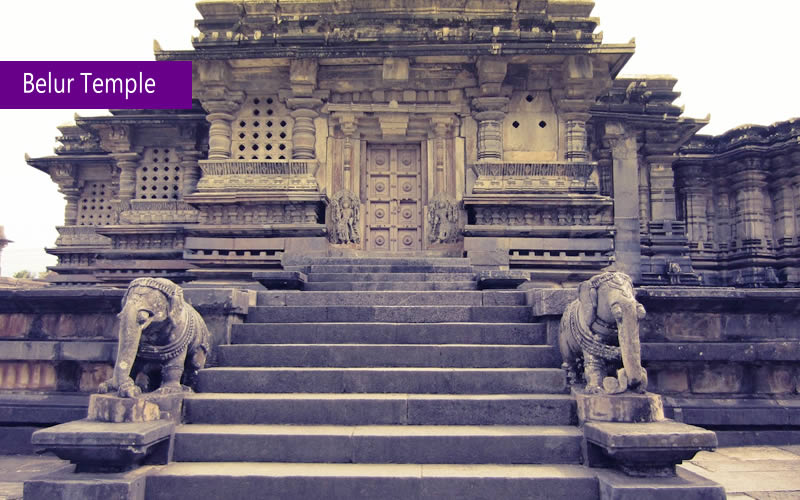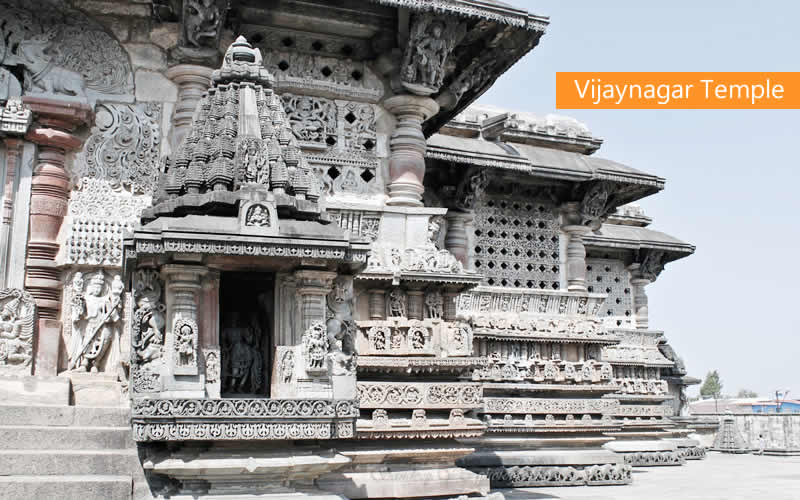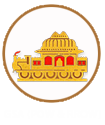The Deccan Experience
- Day 01 : Arrive mumbai by: International Flight
- Day 02 : Mumbai
- Day 03 : Mumbai – Lonavala – Pune
- Day 04 : Pune – Solapur
- Day 05 : Solapur – Bijapur
- Day 06 : Bijapur – Hospet
- Day 07 : Hospet – Hampi – Hospet
- Day 08 : Hospet – Badami – Hubli
- Day 09 : Hubli – Jog-Falls
- Day 10 : Jog Falls – Shimoga
- Day 11 : Shimoga – Udupi – Mangalore
- Day 12 : Mangalore – Hassan
- Day 13 : Hassan – Coorg
- Day 14 : Coorg
- Day 15 : Coorg – Mysore
- Day 16 : Mysore
- Day 17 : Mysore – Bangalore
- Day 18 : Bangalore – Puttaparthi
- Day 19 : Puttaparthi
- Day 20 : Puttaparthi – Bangalore
Tour Highlights:
- Elephanta caves
- Prince of Wales Museum
- Belur Temple
- Vijay Nagar Temples
Tour Schedule - The Deccan Experience
Day 01: ARRIVE: MUMBAI BY: INTERNATIONAL FLIGHT
- You will arrive in the morning at Mumbai International Airport. Following customs, immigration formalities and baggage collection, a YATRA representative will meet you as you EXIT the ARRIVALS TERMINAL building after which you will be transferred to hotel, where you will proceed for check-in.
- Mumbai – It is young, its lively and a confluence of varied cultural currents and cross currents have given Mumbai a unique position of the most multi-ethnic city of India. The capital city of Maharashtra State, formerly known as Bombay lies in the southwestern part of India.
- Oozing with the cocksure self-confidence of a maverick moneymaker and “Bindass” (carefree) attitude, Mumbai is also country’s financial and commercial hub and has a principal port on the Arabian Sea. Mumbai is the hub of Indian film industry, which has played a pivoted role in the development of cinematography. “Bollywood”, as it is called, produces the second most number of pictures in the world every year, next only to Hollywood, U.S.A. Mumbai claims to be the world’s largest production centre for films.
- Overnight at the hotel
Day 02: MUMBAI
- Breakfast at the hotel Morning visit, Elephanta Island (closed on Mondays) was known in ancient times as “Gharapuri” or The Place of Caves. The Portuguese took possession of the island and named it Elephanta after the great statue which they found on the seashore. There are seven caves of which the most important is the Mahesha-Murti Cave.
- The main body of the cave, excluding the porticoes on the three open sides and the back aisle, is 27 m square and is supported by rows of six columns. The gigantic figures of Dvarapalas, or doorkeepers are very impressive. The cave temple, dedicated to Lord Shiva, was excavated some time in the 8th century by the Rashtrakuta Kings who ruled the area between AD 757-973. Elephanta closely follows the pattern of the Dumar Lena cave in Ellora.
- The tour starts from the Gateway of India where the motor launch drops you back after the excursion to Elephanta caves. Gateway of India is the landmark of Bombay, which, was before the advent of air travel, the only gateway to India. It was built to commemorate the visit of King George and Queen Mary to India in 1911.
- You will be then driven along Marine Drive, the sea – Front Boulevard. It is also known as the Queen’s Necklace as in the evening, the breeze from the Arabian Sea comes over Marine Drive and as the streetlights on this U-shaped road light up, the view from south Bombay’s skyscrapers or from the exclusive residential area, is that of a Queen’s Necklace. Your first stop will be the Jain Temples, built of marble and dedicated to the first Jain Tirthankara.
- From the temples you will be driven along Malabar Hill via the Tower of Silence – a round stone construction on which Parsis place their dead to be eaten by the vultures and Hanging Gardens which is built over Bombay’s reservoir. From here one can get a panoramic view of picturesque Marine Drive.
- From Malabar Hill you will be driven to the Dhobi Ghats a huge open-air laundry, which makes an interesting viewing. Continue to Mani Bhawan (Gandhi Memorial), the house where the Father of the Nation stayed on his early visits to the city. The room, in which Gandhi stayed, preserved as it was, and the scenes of Gandhi’s life in photographs and models are of special interest.
- The last stop before proceeding to the hotel is the Prince of Wales Museum – gothic and Moorish architecture in the striking confluence of styles that came to be known as Indo Saracenic. It boasts of a significant collection of Indus valley artefacts some of them dating back to more than 5000 years. Most impressive are the miniature paintings – nearly 2000 of them – from various stylistic schools of India.
- Overnight at the hotel
Day 03: MUMBAI – LONAVALA – PUNE
- After buffet breakfast you will be driven to Pune (166 hours / 4 hours), en-route visit Lonavala – It is set amongst the slopes of the Sahyadri mountain range. Also known as the “Jewel of The Sahyadri”, Lonavala is a place of this region where nature is present in its entire splendor. It has become famous because of nature’s gift of beautiful valleys, hills, milky waterfalls, lush greenery, and pleasant cool winds.
- After sightseeing continue driving to Pune. Upon arrival check-in at hotel
- From its humble beginnings as a village of musicians, Pune grew into a centre for academics and culture before metamorphosing into an industrial power horse of the western Indian state of Maharashtra.
- In the meantime, its pleasant weather and hilly green environment attracted the British who established a cantonment here and transformed Pune into a major garrison town. Visitors to contemporary Pune find it an exciting ‘happening’ place with a cosmopolitan atmosphere and tremendous potential. Modern Pune is home to industrialists, artistes, academics, students, retired civil servants and military personnel and acolytes of Osho
- Later you will proceed for sightseeing tour of Pune visit The Aga Khan Palace is an impressive colonial style building. It is of national and historical relevance as the British confined Mahatma Gandhi at the Aga Khan palace under house arrest. The palace’s salons and suites housed leaders of the Freedom Struggle and many an important meeting was held here during the Quit India Movement in 1942.
- Also visit Shaniwarwada is the erstwhile palace of the Peshwas, was built in 1736 and destroyed in a major fire in 1827. But the remains that include fortified outer walls; a lotus pond and a majestic Nagarkhana give a glimpse of past grandeur.
- Return to your hotel after sightseeing tour
- Overnight at the hotel
Day 04: PUNE – SOLAPUR
- After buffet breakfast at hotel, you will be driven from Pune to Solapur (242 Kms / 5 hours), upon arrival check-in at hotel.
- Solapur is one of the biggest city in Maharashtra, situated on the borders of the Karnataka and Andhra Pradesh. It’s an ancient historical and religious place with Shri Siddharameshwar as its “Gramadaiwata”. Shri Siddharameshwar was a historical personality of the 12th Century whose “Karmayoga” on his own native land-Solapur, turned him into a God-figure in course of time. Solapur is the hub of cotton mills and power looms. The bed sheets of Solapur are world famous.
- Later proceed for city tour of Solapur visit the Siddheshwar Tempel (Lord Shiva). It is located near a lake front and has very beautiful surroundings.
- Return to your hotel after sightseeing tour.
- Overnight at the hotel
Day 05: SOLAPUR – BIJAPUR
- After buffet breakfast at hotel, you will be driven from Solapur to Bijapur (109 Kms / 2 hours), upon arrival check-in at hotel.
- The foundations of this historic city were laid during the reign of the Chalukyan dynasty of Kalyani between the tenth and eleventh centuries. They called it Vijayapura or the “City of Victory” from which comes its present name Bijapur.
- Bijapur came under Muslim influence, first under Allaudin Khilji, the Sultan of Delhi, towards the end of the 13th century, and then under the Bahamani kings of Bidar in 1347. Bijapur became the capital of the Adil Shah dynasty (1489 to 1686) and it’s charm lies largely in the architectural legacy from those Days. The Adil Shahs had broken away from the Muslim Bahamanis who had ruled parts of south India, to establish their kingdom in the northwest part of Karnataka.
- Later you will proceed for sightseeing tour of Bijapur visit the Gol Gumbaz. This gigantic mausoleum of Mohammed Adil Shah has to its credit the second largest dome in the world after that of St. Peter’s in Vatican City. It also has a whispering gallery where a message carries through 38 meters repeating 11 times.
- Continue your drive to visit Ibrahim Roza, quite at the other end of the stylistic spectrum from the Gol Gumbaz. This graceful monument is the tomb of Ibrahim Adil Shah and his family. Decorated with delicate stone filigree and other sculptural work, this building is admired for its loveliness rather than imposing grandeur. Close by The Jami Masjid it is thought to be the most beautiful mosque in south India
- Return to your hotel after sightseeing tour.
- Overnight at the hotel
Day 06: BIJAPUR – HOSPET
- After buffet breakfast at hotel, you will be driven from Bijapur to Hospet (250 Kms / 5 hours), upon arrival check-in at hotel.
- Rest of the Day free to relax.
- Overnight at the hotel
Day 07: HOSPET – HAMPI – HOSPET
- After buffet breakfast, proceed for a full Day excursion to Hampi.
- Hampi, a World heritage centre is the most beautiful and evocative of all the ruins in Karnataka. The erstwhile Capital of the Vijayanagar Kingdom, Hampi is full of delightful surprises. Like the King’s Balance where the King was weighed against grain, gold or money which was then distributed to the poor. The Queen’s Bath with its arched corridors, projecting balconies and lotus shaped fountains that once sprouted perfumed water. The two storeyed Lotus Mahal with recessed archways, the huge elephant stables, the splendid Vithala Temple with its musical pillars and the stone chariot.
- The Virupaksha Temple, still used for worship, Ugra Narasimha the 6.7 m tall monolith, the Pushkarini Tank, the Mahanavmi Dibba. The once-powerful Vijayanagar Empire was compared to the Roman Empire by a Portuguese traveler.
- Overnight at the hotel
Day 08: HOSPET – BADAMI – HUBLI
- After buffet breakfast, you will be driven from Hospet to Hubli (285 KMS / 7 hours), en-route visiting Badami Caves.
- After buffet breakfast proceed for a sightseeing tour of Badami Caves
- Sightseeing tour of Badami Caves, the capital of the Chalukyas. Badami is picturesquely situated at the mouth of a ravine between two rocky hills. It has four rock-cut cave temples, the largest dedicated to Vishnu. Overlooking the temples is a reservoir with its banks dotted with Temples dedicated to Vishnu and Shiva. Also of interest are Bhutanatha Temples and the Museum
- Cave 1: Dates back to 578 A.D. and was probably the first to be carved. One has to climb up 40 odd steps to reach the colonnaded verandah, a hall with numerous pillars and a square shaped sanctum hollowed in the control back wall. On the ceiling one can see the paintings of amorous couples. Shiva and his consort Parvati, and a coiled serpent. The 18-armed lord Nataraja can be seen in 81 dancing poses.
- Cave 2: Dedicated to lord Vishnu depicted here as a dwarf or ‘Trivikrama’ of awesome dimensions with one foot mastering the Earth and the other the sky, the second cave is atop a sandstone hill. Vishnu here is depicted as a dwarf. Another form of Vishnu portrayed here is as ‘Varaha’ or as a boar. Then there is a frieze endearingly depicting Vishnu as Lord Krishna.
- Cave 3: Still going higher up one comes across this cave antedating 578 A.D. The facade of the cave is nearly 70 feet wide; on the plinth one can see the carvings of ganas. The sheer artistry and sculptural genius makes this cave the highlight of Deccan art. It gives a virtual insight into the art and culture of the 6th century like costumes, jewelry hairstyle lifestyle etc. The other attractions to be looked carefully in this cave are the high relief of Vishnu with a serpent, Vishnu as Narasimha (Vishnu as Man-Lion) Varaha, Harihara (Shiva Vishnu) and Vishnu as Trivikrama.
- Cave 4: The only Jain cave, the construction of Cave four started in the 6th century and completed after nearly 100 years later then the earlier three caves. Here one can see the carvings of the Tirthankara Parshavnatha with a serpent at his feet; Mahavira in a sitting posture also can be seen in the shrine
- Continue your drive to Hubli and upon arrival, proceed for check-in at your hotel.
- Overnight at the hotel
Day 09: HUBLI – JOG FALLS
- After buffet breakfast at hotel you will be driven to Jog Falls (173 Kms / 4 hours), upon arrival check-in at hotel.
- Later proceed to visit the Jog Falls. The wondrous sight is that of river Sharavathi taking a spectacular leap into the chasm from a height of 900 feet to from the highest waterfalls in India. The river Sharavathi hurtles in 4 distinct cascades. The first of these falls is known as the ‘Raja’ – the grandest, an unbroken sheet of water, the Raja plunges into the vapor shrouded poll 900 feet below.
- A few 100 feet way down, with a thunderous gush, Raja is joined by ‘Roarer’. Leaping down with great speed in a series of cascades in the ‘Rocket’. And gliding away in a feminine grace ‘Rani’. The effect is greatly heightened by the wild and beautiful region around which is covered with a wealth of luxuriant vegetation. The steps cut into rocks will lead you to the very depths of the fall and shower you with vaporous spray that bounces off these rocks.
- Overnight at the hotel
Day 10: JOG FALLS – SHIMOGA
- After leisurely buffet breakfast you will be driven from Jog Falls to Shimoga (104 Kms / 2 hours), upon arrival check-in at hotel.
- Shimoga is a true picture of nature’s bounty-landscapes dotted with waterfalls, swaying palms and lush paddy fields make for picturesque locales. Shimoga, almost central on the Karnataka map is the rice bowl of the State. The rivers Tungabhadra, Sharavathi, Varada and Kumudavathi inundate the luxuriant greens of the region.
- Shimoga was ruled by the great Indian dynasties of the Kadambas, Gangas, Chalukyas, Rastrakutas, Keladi and Vijaynagar Kings. Shimoga (Face of Shiva), was established by the Keladi rulers. It reached its pinnacle during the rule of Shivappa Nayaka around 1600 A.D.
- Rest of Day is at leisure.
- Overnight at the hotel
Day 11: SHIMOGA – UDUPI – MANGALORE
- After buffet breakfast you will be driven from Shimoga to Mangalore (200 Kms / 3 hours), en-route visiting Ashtamathas (Eight Sanyasi Mutts) at Udupi also known as abode of lord Krishna. This mutt was established by Madhwacharya the propounder of Dwaitha philosophy, lived and taught 700 years ago. According to legend, the statue of Sri Krishna in the famous temple here is believed to have turned around to give darshana to the kuruba devotee, Kanakadasa, who was not allowed to enter the temple because Kanakadasa belonged to a different caste. It is best known as the seat of Madhwa renaissance, founded by the sage Madhwacharya, outcome of which are Ashtamathas, located in the famous Car Street, surrounding the Sri Krishna Temple.
- Besides temples Udupi is also famous for its mouth watering cuisines and restaurant.
- After lunch continue driving to Mangalore, upon arrival check-in at the hotel.
- Mangalore, the land of ancient mystique and modern outlook is situated in the plains within the embrace of 2 rivers and built over several hills. Mangalore has a rich and varied tradition. Coming into prominence during the reign of the Vijaynagara kings, it was coveted by the Portuguese, the Mysore sultans and the English, under whom it remained until independence.
- The layers of hillocks that tower one above the other make interesting sights. The tile-roofed houses that are shaded by the pliant arches of the coconut palms tell us about the exotic fragrance of cashews and coffee beans as they get mixed with the mundane smell of baking tiles. The tender coconut arranged beside the footpaths, the packed arrecanuts in bags are the essential local products.
- Later you will proceed for sightseeing tour of Mangalore visit the cashew nut factory to observe the different processing stages of the cashew that forms it into the familiar shape available in the market.
- From here you will be taken to Kadri Hills to get a panoramic view of the city of Mangalore. Kadri Hills also has a very interesting deer & snake park and a temple dedicated to Lord Manjunatha dating back to 1068 and its central image of the God is a remarkable bronze. From here we will proceed to the St. Aloysius Chapel – built in 1885 built by the Italian missionaries, the chapel inside has marvelous murals covering its walls and ceilings depicting the life of Jesus Christ. This chapel is sometimes referred to as `the Sistine Chapel’ of India.
- Overnight at the hotel
Day 12: MANGALORE – HASSAN
- After early breakfast you will be driven from Mangalore to Hassan (172 kms / 3. 5 hours), upon arrival check-in at hotel.
- Afternoon you will proceed to visit the Halebid. Halebid was the capital of the great Hoysala kingdom from 1311 to 1327, when it got destroyed during a Delhi Sultanate attack. Originally called Dvarasamudra, it was renamed Halebidu (or ‘old capital’) when the seat of power shifted. The Hoysaleswara Temple is the largest Hoysala temple and luckily it survived the attack by the northern invaders. Actually two shrines, both dedicated to Lord Shiva, both with rather big Nandi bulls facing the entrance, this temple was never really completed in spite of the 87 years that were poured into its construction.
- Begun in 1121 this temple has beautifully carved detailed depictions of scenes from the epics, of mythical seemingly Gothic figures and sculptures of much of the Hindu divine pantheon. Though the superstructure was never completed every inch of the existing structure is covered with intricate painstakingly carved sculpture.
- Later drive to Belur and visit the temples, which stand in courtyard with a famous Chennakesava temple near the center. One of the earliest of its type started during the period when the great Cathedrals of Europe such a Lincoln and Rheims were built which took a century.
- After sightseeing return to your hotel.
- Overnight at the hotel
Day 13: HASSAN – COORG
- After early breakfast you will be driven from Hassan to Coorg (172 kms / 3. 5 hours), upon arrival check-in at hotel.
- Cradled in the cleft of verdant green valleys, caressed by the bubbly waters of river Cauvery, Coorg is a virtual paradise on earth crowned with glorious mist cloaked hills and graced with tiny springs. Unlike most tourist spots, Coorg still retains its Old World charm intact. It offers crisp air, thick tropical forests, miles of exotic spices & coffee plantations and extensive paddy fields apart from abundance of flora and bird life.
- Rest of the Day free to relax.
- Overnight at the hotel
Day 14: COORG
- After buffet breakfast at hotel. Morning free to explore the coffee plantation around your resort.
- Later you will proceed for excursion to Duber Forest to visit the Elephant Training Camp.
- This is mainly an elephant capturing and training camp of the Forest Department, at the edge of Dubare forest, on the bank of river Kaveri. The largest land animal is captured here with the help of tamed elephants and local tribals – the Kurbas – and is held captive for upto 6 months in large teak wood cages.
- The tamed elephants attend to various jobs during the Day and in the evenings they come down to the river to bathe and to be scrubbed clean by their mahouts. Afterwards the mahout obliges eager tourists for free elephant rides within the camp. In the evenings, all the elephants are offered a special treat of ladoos made of ragi and jaggery, each no smaller than a cannon ball.
- Return to your hotel after tour.
- Overnight at the hotel
Day 15: COORG – MYSORE
- After early breakfast you will be driven from Coorg to Mysore (120 kms / 3 hours), upon arrival check-in at hotel.
- Once the capital of a princely state, Mysore still carries on its placid shoulders the aura and glamour of palaces, the grandeur of festivals of times gone by, but all of it with a quiet, unhurried dignity. Mysore is often called the Jewel of Karnataka – its arts, culture, buildings, festivals, gardens and parks being the quintessence of the state’s heritage.
- Rest of the Day is at leisure.
- Overnight at the hotel
Day 16: MYSORE
- After buffet breakfast at hotel proceed for sightseeing tour of Mysore After buffet breakfast you will proceed for sightseeing of Mysore visit the Maharaja Palace – The infatuation with Mysore begins with the Maharaja’s Palace, at the heart of the city. It is a veritable treasure trove of exquisite carvings and works of art from the world over.
- Overlooking the city of Mysore are the Chamundi Hills, where stands a monolithic statue of the Nandi Bull. Proceed to the Rajendra Art Gallery has some remarkable selections of paintings by Raja Ravi Verma, Nicholas Roerich and traditional paintings in the Mysore style.
- Afternoon free for independent activities.
- Overnight at the hotel
Day 17: MYSORE – BANGALORE
- Afternoon you will be driven to Bangalore (140 Kms / 3 hours) en-route visiting Srirangapatnam – the remains of the fort and the Hindu temples and the summer Palace of Tipu Sultan. This little town of Srirangapatnam played an important role in the region since its origins in the 10th century, being the focal point in South India’s political development, the fort was built under the Vijaynagar kings in 1454, 150 years later the last Vijaynagar king handed over authority to the Hindu Wodeyars of Mysore, who made it their capital. In the second half of the 18th century, it became the capital of Haidar Ali, who defended it against the Marathas.
- Upon arrival at Bangalore, check-in at hotel.
- Built in the 16th century by the feudal lord, enlarged by the legendary Tipu Sultan and later laid out by the British, Bangalore is undoubtedly one of India’s most gracious cities. The wide roads and open spaces, architectural landmarks and beautiful gardens lend it a deceptively unhurried appearance. But contrary to that, ‘India’s Silicon Valley’ is one of Asia’s fastest growing cities.
- Afternoon proceed for sightseeing tour of Bangalore visit Lalbagh, the botanical garden spread over 240 acres and having a wide variety of exotic trees and plants, The Vidhan Sabha which houses the State Legislative assembly and part of the secretariat, Tipu Sultan’s Palace constructed between 1781 – 1791 was once the summer residence of Tipu Sultan.
- Finally visit the Bull Temple believed to have been constructed in the 16th century, has been carved out of a single granite block.
- Overnight at the hotel
Day 18: BANGALORE – PUTTAPARTHI
- After buffet breakfast you will driven to Puttaparthy (120 Kms / 3 hours), upon arrival check-in at hotel.
- Puttaparthi, once a sparsely populated village, has shot into national and international fame as the abode of Bhagwan Sri Satya Sai Baba. The original name of Sai Baba is “Satyanarayana Raju”. He was born on November 23, 1926 in Puttaparthi. Sri Sathya Sai Baba, the most colourful and multifaceted prophet, modern India has produced, is believed to be the very avatar (incarnation) of love and the voice of one’s own innermost heart speaking to each individual externally.
- The teachings of the Baba are based on the famous ‘five props’ of Sathya (truth), Dharma (righteousness) Santhi (peace), Prema (universal love) and Ahimsa (non violence). Prasanthi Nilayam, over the years, has attracted people from all over then world. The Ashram has a code of conduct which every visitor should follow. The Ashram also has museums, stadiums, educational institutions, the Sai Space Theatre etc. The 23rd of November is celebrated with great joy and enthusiasm by the devotees of Baba at the Prasanthi Nilayam.
- Rest of Day free to attend prayer sessions.
- Overnight at the hotel
Day 19: PUTTAPARTHI
- Buffet breakfast at hotel. Day free to explore the ashram and attending the prayer sessions.
- Overnight at the hotel
Day 20: PUTTAPARTHI – BANGALORE
- DEPARTURE: BANGALORE BY: INTERNATIONAL FLIGHT
- Buffet breakfast at hotel.
- Later in the afternoon you will be driven back to Bangalore. Upon arrival you will be met by the YATRA representative who will transfer you to International airport to board the flight to back home.
*Note: All flight details and timings are subject to change.


